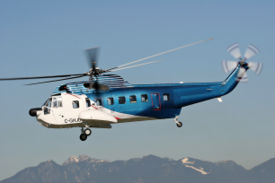PlaneSpottingWorld welcomes all new members! Please gives your ideas at the Terminal.
Sikorsky S-61
| S-61L/S-61N | |
|---|---|
| HeliJet's S-61N at Vancouver International Airport | |
| Type | Medium-lift transport/airliner helicopter |
| Manufacturer | Sikorsky |
| Maiden flight | March 11 1959 |
| Status | Active service |
| Primary users | Canadian Coast Guard Bristow Helicopters HeliJet New York Airways |
| Number built | 119[1] |
| Developed from | SH-3 Sea King |
| Variants | Sikorsky S-61R |
The Sikorsky S-61L and S-61N are civil variants of the successful SH-3 Sea King helicopter. They are two of the most widely used airliner and oil rig support helicopters built.[1]
Contents
Design and development
In September 1957, Sikorsky won a US Navy development contract for an amphibious anti-submarine warfare (ASW) helicopter capable of detecting and attacking submarines.[1] The XHSS-2 Sea King prototype flew on March 11 1959. Production deliveries of the HSS-2 (later designated SH-3A) began in September 1961, with the initial production aircraft being powered by by two 930kW (1250shp) General Electric T58-GE-8B turboshafts.
Sikorsky was quick to develop a commercial model of the Sea King.[1] The S-61L first flew on November 2 1961, and was 4ft 3in (1.27m) longer than the HSS-2 in order to carry a substantial payload of freight or passengers. Initial production S-61Ls were powered by two 1350shp (1005kW) GE CT58-140 turboshafts, the civil version of the T58. The S-61L features a modified landing gear without float stabilisers.
On August 7 1962, the S-61N made its first flight.[1] Otherwise identical to the S-61L, this version is optimized for overwater operations, particularly oil rig support, by retaining the SH-3's floats. Both the S-61L and S-61N were subsequently updated to Mk II standard with improvements including more powerful CT58-110 engines giving better hot and high performance, vibration damping and other detail refinements.
The Payloader, a stripped down version optimised for aerial crane work, was the third civil model of the S-61.[1] The Payloader features the fixed undercarriage of the S-61L, but with an empty weight almost 2000lb (900kg) less than the standard S-61N.
A unique version is the S-61 Shortsky conversion of S-61Ls and Ns by Helipro International.[1] The fuselage is shortened by 50in (1.6m) to increase single engine performance and external payload. The Shortsky conversion first flew in February 1996.
Variants
- S-61L
- Non-amphibious civil transport version. It can seat up to 30 passengers (13 Built).
- S-61L Mk II
- Improved version of the S-61L helicopter.
- S-61N
- Amphibious civil transport version.
- S-61N Mk II
- Improved version of the S-61N helicopter.
- S-61 Payloader
- Stripped down machine optimised for aerial crane work; features the fixed undercarriage of the S-61L, but with an empty weight almost 900kg (2000lb) less than the standard S-61N.
- S-61 Shortsky
- Shortened conversion of the S-61L and N, designed to increase single engine performance and external payload.
Operators
- BEA Helicopters
- Bristow Helicopters
- British Airways
- British Caledonian Helicopters
- British International Helicopters
- Carson Helicopters
- Croman Corporation
- San Bernardino County, California Sherrif's Department
Specifications (S-61N Mk II)
Data from International Directiory of Civil Aircraft[1]
General characteristics
- Crew: 2 pilots
- Capacity: up to 30 passengers
- Length: 58 ft 11 in (17.96 m)
- Rotor diameter: 62 ft (18.9 m)
- Height: 17 ft 6 in (5.32 m)
- Disc area: 3,019 ft² (280.6 m²)
- Empty weight: 12,336 lb (5,595 kg)
- Loaded weight: lb (kg)
- Max takeoff weight: 19,000 lb (8,620 kg)
- Powerplant: 2× General Electric CT58-140 turboshafts, 1,500 shp (1,120 kW) each
Performance
- Maximum speed: 166 mph (267 km/h)
- Cruise speed: 120 kn (222 km/h)
- Range: 450 NM (833 km)
- Service ceiling: 12,500 ft (m)
- Rate of climb: 1,310-2,220 ft/min (400-670 m/min)
References
External links
- Sikorsky S-61N on avia.russian.ee
- Canadian Coast Guard S-61N Characteristics page
- "Helipro Shortsky enters service" FlightGlobal
- S-61N Specs & Photo on flugzeuginfo.net
Related content
Related development
Designation sequence
Related lists
See also
Lists relating to aviation | |
|---|---|
| General | Timeline of aviation · Aircraft · Aircraft manufacturers · Aircraft engines · Aircraft engine manufacturers · Airports · Airlines |
| Military | Air forces · Aircraft weapons · Missiles · Unmanned aerial vehicles (UAVs) · Experimental aircraft |
| Notable incidents and accidents | Military aviation · Airliners · General aviation · Famous aviation-related deaths |
| Records | Flight airspeed record · Flight distance record · Flight altitude record · Flight endurance record · Most produced aircraft |


